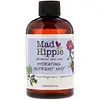What's inside
What's inside
 Key Ingredients
Key Ingredients

 Benefits
Benefits

 Concerns
Concerns

No concerns
 Ingredients Side-by-side
Ingredients Side-by-side

Water
Skin ConditioningAscorbic Acid
AntioxidantPhenethyl Alcohol
MaskingCaprylyl Glycol
EmollientEthylhexylglycerin
Skin ConditioningGlycerin
HumectantSodium PCA
HumectantCamellia Sinensis Leaf Extract
AntimicrobialCitrus Aurantifolia Peel Extract
CleansingSodium Hyaluronate
HumectantFerulic Acid
AntimicrobialHesperidin
EmollientVitis Vinifera Seed Extract
AntimicrobialGinkgo Biloba Leaf Extract
Skin ConditioningPunica Granatum Extract
AstringentResveratrol
AntioxidantSorbitan Oleate Decylglucoside Crosspolymer
CleansingBeta-Glucan
Skin ConditioningAcetyl Glucosamine
Skin ConditioningPinus Strobus Bark Extract
Skin ConditioningGlycine Soja Sterols
EmollientSophora Japonica Fruit Extract
Skin ConditioningSilybum Marianum Fruit Extract
Skin ConditioningThioctic Acid
AntioxidantWater, Ascorbic Acid, Phenethyl Alcohol, Caprylyl Glycol, Ethylhexylglycerin, Glycerin, Sodium PCA, Camellia Sinensis Leaf Extract, Citrus Aurantifolia Peel Extract, Sodium Hyaluronate, Ferulic Acid, Hesperidin, Vitis Vinifera Seed Extract, Ginkgo Biloba Leaf Extract, Punica Granatum Extract, Resveratrol, Sorbitan Oleate Decylglucoside Crosspolymer, Beta-Glucan, Acetyl Glucosamine, Pinus Strobus Bark Extract, Glycine Soja Sterols, Sophora Japonica Fruit Extract, Silybum Marianum Fruit Extract, Thioctic Acid
Water
Skin ConditioningPolyglyceryl-10 Laurate
Skin ConditioningGlyceryl Citrate/Lactate/Linoleate/Oleate
EmulsifyingSqualane
EmollientGlycerin
HumectantPanthenol
Skin ConditioningSodium Hyaluronate
HumectantHydrolyzed Sodium Hyaluronate
Skin ConditioningEnteromorpha Compressa Extract
Skin ProtectingLysine
Skin ConditioningMagnesium Chloride
Sodium Chloride
MaskingPotassium Chloride
Zinc Chloride
AntimicrobialPyrus Malus Fruit Extract
Skin ConditioningLavandula Angustifolia Oil
MaskingCitrus Nobilis Peel Oil
MaskingPelargonium Graveolens Flower Oil
MaskingSodium Stearoyl Glutamate
CleansingPolyglyceryl-4 Cocoate
EmollientPolyglyceryl-3 Caprate
EmulsifyingGlyceryl Caprylate
EmollientTetrasodium Glutamate Diacetate
Citric Acid
BufferingCaprylyl Glycol
EmollientEthylhexylglycerin
Skin ConditioningPhenoxyethanol
PreservativeHexylene Glycol
EmulsifyingLimonene
PerfumingCitronellol
PerfumingGeraniol
PerfumingLinalool
PerfumingWater, Polyglyceryl-10 Laurate, Glyceryl Citrate/Lactate/Linoleate/Oleate, Squalane, Glycerin, Panthenol, Sodium Hyaluronate, Hydrolyzed Sodium Hyaluronate, Enteromorpha Compressa Extract, Lysine, Magnesium Chloride, Sodium Chloride, Potassium Chloride, Zinc Chloride, Pyrus Malus Fruit Extract, Lavandula Angustifolia Oil, Citrus Nobilis Peel Oil, Pelargonium Graveolens Flower Oil, Sodium Stearoyl Glutamate, Polyglyceryl-4 Cocoate, Polyglyceryl-3 Caprate, Glyceryl Caprylate, Tetrasodium Glutamate Diacetate, Citric Acid, Caprylyl Glycol, Ethylhexylglycerin, Phenoxyethanol, Hexylene Glycol, Limonene, Citronellol, Geraniol, Linalool
Alternatives
Ingredients Explained
These ingredients are found in both products.
Ingredients higher up in an ingredient list are typically present in a larger amount.
Caprylyl Glycol is a humectant and emollient, meaning it attracts and preserves moisture.
It is a common ingredient in many products, especially those designed to hydrate skin. The primary benefits are retaining moisture, skin softening, and promoting a healthy skin barrier.
Though Caprylyl Glycol is an alcohol derived from fatty acids, it is not the kind that can dry out skin.
This ingredient is also used as a preservative to extend the life of products. It has slight antimicrobial properties.
Learn more about Caprylyl GlycolEthylhexylglycerin (we can't pronounce this either) is commonly used as a preservative and skin softener. It is derived from glyceryl.
You might see Ethylhexylglycerin often paired with other preservatives such as phenoxyethanol. Ethylhexylglycerin has been found to increase the effectiveness of these other preservatives.
Glycerin is already naturally found in your skin. It helps moisturize and protect your skin.
A study from 2016 found glycerin to be more effective as a humectant than AHAs and hyaluronic acid.
As a humectant, it helps the skin stay hydrated by pulling moisture to your skin. The low molecular weight of glycerin allows it to pull moisture into the deeper layers of your skin.
Hydrated skin improves your skin barrier; Your skin barrier helps protect against irritants and bacteria.
Glycerin has also been found to have antimicrobial and antiviral properties. Due to these properties, glycerin is often used in wound and burn treatments.
In cosmetics, glycerin is usually derived from plants such as soybean or palm. However, it can also be sourced from animals, such as tallow or animal fat.
This ingredient is organic, colorless, odorless, and non-toxic.
Glycerin is the name for this ingredient in American English. British English uses Glycerol/Glycerine.
Learn more about GlycerinSodium Hyaluronate is hyaluronic acid's salt form. It is commonly derived from the sodium salt of hyaluronic acid.
Like hyaluronic acid, it is great at holding water and acts as a humectant. This makes it a great skin hydrating ingredient.
Sodium Hyaluronate is naturally occurring in our bodies and is mostly found in eye fluid and joints.
These are some other common types of Hyaluronic Acid:
Learn more about Sodium HyaluronateWater. It's the most common cosmetic ingredient of all. You'll usually see it at the top of ingredient lists, meaning that it makes up the largest part of the product.
So why is it so popular? Water most often acts as a solvent - this means that it helps dissolve other ingredients into the formulation.
You'll also recognize water as that liquid we all need to stay alive. If you see this, drink a glass of water. Stay hydrated!
Learn more about Water